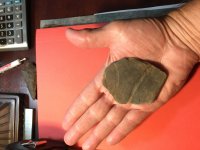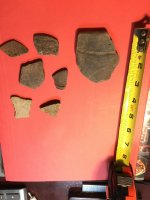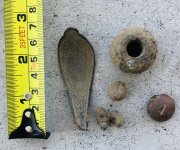Clay Slayer
Sr. Member
- Jan 4, 2011
- 300
- 338
- Detector(s) used
-
Equinox 800,
Garrett Pro Pointer
- Primary Interest:
- Metal Detecting
Most pottery shards I find are about an inch or so in size. I found this one this morning about 10ft out beyond the surf zone during a slack tide in about a foot of water...the water was calm and pretty clear. This is the largest pottery piece I have ever found and I really like the indented pattern. This is about the same area where I found my first point in my previous post. I think I'm going to really like searching this area.
Sorry, my photos seem to be uploading with the wrong orientation for some reason. When you select one, it displays correctly, go figure.


Sorry, my photos seem to be uploading with the wrong orientation for some reason. When you select one, it displays correctly, go figure.


Upvote
0





